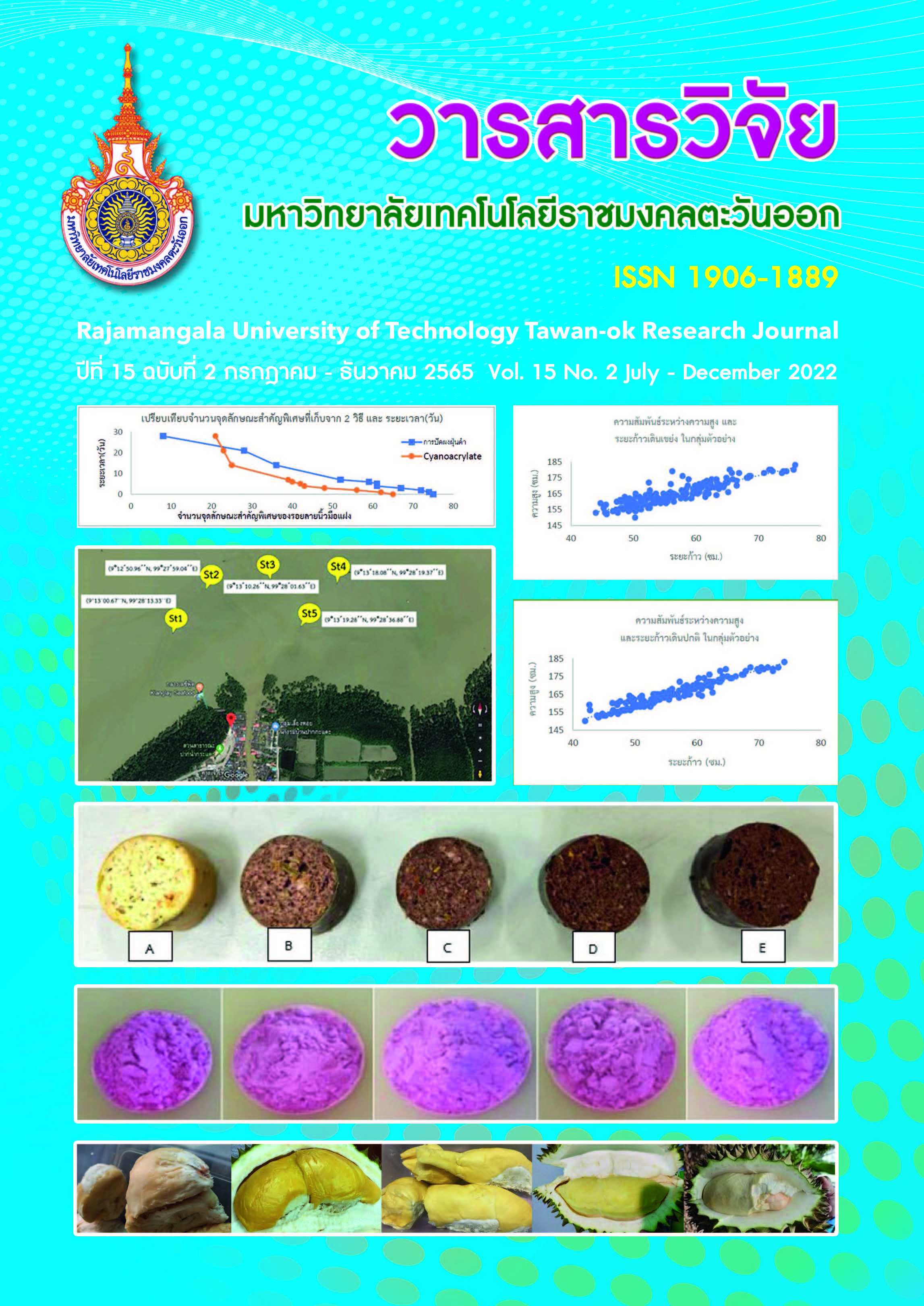The Study of Chemical Properties and Sensory Test of Sato (Glutinous Rice Wine)
Main Article Content
Abstract
The research objective aimed to examine chemical properties by using a sensory test on rice wine from Glutinous rice RD.6, Nang Nual glutinous rice, Leum Pua glutinous rice by using 10 grams of Look-pang (dried yeast) with three kilograms of rice added to 1.50 liters of water for each kilogram of rice. After seven days, the total soluble solid was between 2.00-28.30 °Brix. The alcohol content ranged from 0.85 to 7.90% (v/v), reducing sugar was between 0.19±0.03 to 1.79±0.16 g/l, total sugar ranged from 0.06±0.01 to 1.65±0.01 g/l, and total acidity ranged from 1.50 ± 0.00 to 11.50 ± 0.57 g/l. Antioxidant activities were DPPH radical scavenging activity of rice wine from Glutinous rice RD.6, Nang Nual glutinous rice and Leum Pua glutinous rice between 23.98±5.48 to 39.68±1.23, 61.99±2.17 to 87.51±0.28 and 59.92±4.91 to 88.58±0.10%, respectively. The average scores for sensory evaluations and overall preference of rice wine from Glutinous rice RD.6, Nang Nual glutinous rice and Leum Pua glutinous rice was 6.27±4.86, 6.17±4.25 and 7.80±4.84, respectively. The overall preference of rice wine samples was not significantly different at the 95% reliability level (p<0.05).
Article Details

This work is licensed under a Creative Commons Attribution-NonCommercial-NoDerivatives 4.0 International License.
References
Amatayakul, T., Somsap, N. and Rotsatchakul, P. 2012. Study of volatile compounds in Thai rice wine (sato) produced
from wheat. KKU Research Journal, 17(6), 939-949.
Buathong, K. and Maisont, S. 2016. Product development of Sato from black glutinous rice by red yeast rice (Ang-kak)
mixed Thai traditional fermentation starter (Loog-Pang). Journal of Science and Technology Phranakhon Rajabhat University, 6(6), 70-76. (in Thai)
Chaijamrus, S. and Mouthung, B. 2011. Selection of Thai starter components for ethanol production utilizing malted
rice from waste paddy. Songklanakarin Journal of Science and Technology, 33(2), 163-170.
Chay, C., Elegado, F.B., Dizon, E.I., Hurtada, W.A., Norng, C. and Raymundo, L.C. 2016. Effects of rice variety and
fermentation method on the physiochemical and sensory properties of rice wine. International Food Research Journal, 24(3) , 1117-1123.
Danvirutai, P. and Laopaiboon, P. 2006. Fruit wine and Sato: How to produce with confidence?. 2nd Ed. Klungnana
Printing, Khon Kaen. (in Thai)
Dubois, M., Gilles, K.A., Hamilton, J.K., Rebers, P.A., Smith, F. 1956. Colorimetric method for determination of sugars
and related substances. Analytical Chemistry, 28, 350-356.
Kudpeng, C., Soemphol, W. and Tanamool, V. 2016. Study on Production of Sato from Indigenous Rice Varieties in
Nakhon Ratchasima., pp. BMP1-BMP1-10. In The National and International Graduate Research Conference 2016. Khon Kaen University, Khon Kaen. (in Thai)
Limtong, S., Sintara, S., Suwanarit, P. and Lotong, N. 2002. Yeast Diversity in Thai traditional fermentation starter
(Loog-pang). Kasetsart Journal (Nat Sci), 36, 149-158.
Limtong, S., Sintra, S., Suwanarit, P. and Lotong, N. 2005. Species diversity of molds in Thai traditional fermentation
starters (Loog-Pang). Kasetsart Journal (Nat Sci), 39, 511-518.
Nelson, N. 1944. A photometric adaptation of the Somogyi method for the determination of glucose. Journal of Biological Chemistry, 153, 376-380.
Nuanpeng, S. 2018. Comparison rice vinegar production from Hom-nil rice and Riceberry rice. Agricultural Science
Journal, 49(Suppl.)(2) , 605-608. (in Thai)
Posoongnoen, S. and Thummavongsa, T. 2018. Some chemical compositions and antioxidant properties of local rice
in Nakhon Ratchasima province, Thailand. Burapha Science Journal, 23(2), 971-984. (in Thai)
Sirikhansaeng, P., Phuakkaew, P. and Sirisanguan, N. 2017. Effects of Sato from various rice color on the inhibition of
growth in Escherichia coli and Staphylococcus aureus. Koch Cha Sarn Journal of Science, 39(21), 121-135. (in Thai)
Sirisantimethakom, L., Laopaiboon, L., Danvirutai, P. and Laopaiboon, P. 2008. Volatile compounds of a traditional
Thai rice wine. Biotechnology, 7(3), 505-513.
Siritrakulsak, P., Chutichudet, P., Chutichudet, B., Plainsirichai, M. and Boontiang, K. 2013. Antioxidant activity of
fifteen edible flowers in Maha Sarakham province. Khon Kaen Agriculture Journal, 41(Suppl.)(1), 607-611. (in Thai)
Somogyi, M. 1952. Notes on sugar determination. Journal of Biological Chemistry, 195, 19-23.
Sumret, C., Siriwong, N. and Riebroy, S. 2012. Textural properties and acceptability of cooked black glutinous rice as
affected by soaking and cooking methods, pp. 1-8 In The 50th Kasetsart University Annual Conference. Kasetsart University, Bangkok. (in Thai)
Techavasonyoo, A. 2007. I solation, classification and characterization of yeasts and molds isolated from Loog Pang
for Sato production. Master thesis, Chulalongkorn University. (in Thai)
Thongta, S. and Yongsawatdigul, J. 2011. Quality Changes during rice storage and age accelerating/delaying. Research report Suranaree university of technology, Nakhon Ratchasima. (in Thai)
Yamuangmorn, S. and Thebault Prom-u-thai, C. 2016. Variation of anthocyanin content and antioxidant capacity
among local Thai purple glutinous rice genotypes. Journal of Agriculture, 32(2), 191-199. (in Thai)
Yoshizawa K. 1999. Sake: Production and Flavor. Food Reviews International, 15(1) : 83-107.


